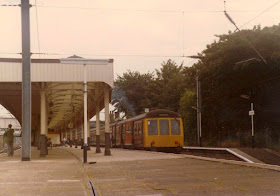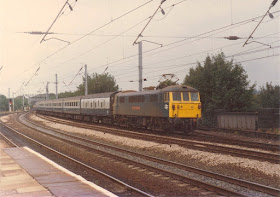LANCASTER
Results of a couple of hours photographing at this busy WCML station back in 1984. Note corporate blue in abundance and a couple of appearances of the prototype APT tilting train tilting, together with first generation DMUs, classic electrics, class 31 and class 47.
More info (from Wikipedia)
History

The 1852 extension includes a relief carving of the
coat of arms of Lancaster.
Originally known as 'Lancaster Castle Station' in order to distinguish it from the
first Lancaster Station (1840–1849), Lancaster station was officially opened on 21 September 1846. The first public service ran into the station on 17 December the same year. The station was built as the southern terminus of the
Lancaster and Carlisle Railway after the initial planned route for the line - which would have followed the
Lancaster Canal and crossing the
River Lune from Ladies Walk to Skerton - was changed in favour of a cheaper route west of the city.
The station was remodelled in 1900-1906 when additional lines and platforms were added and further station buildings constructed.
[2] The new buildings were styled mock-Elizabethan with the intention of mirroring the battlements of the nearby
Lancaster Castle. Platforms 5 and 6 (on the east side of the station) were electrified in 1908 to serve the now-closed
Midland Railway route to Morecambe and Heysham. This line closed in January 1966 and the overhead line equipment was removed.
The track layout in the station area was rationalised in 1973 when control of the signalling was transferred to the new Preston Power Signal Box. This included the removal of the track from Platform 6, although this platform had seen no regular use for some time prior to this. The
West Coast Main Line through Lancaster was electrified in 1974, and regular electric passenger services recommenced at the station 7 May 1974.
Description
The main building constructed in 1846 by
William Tite was situated on the west side of the line in
Tudor Revival style using roughly squared sandstone rubble. This two-storey building was extended southwards in 1852 in similar style although this section terminated in a tower of three storeys. A new entrance was constructed in 1900 on the eastern side of the line at footbridge level; this is nearer the town and houses the remaining ticket office.
The entrance through the original building remains open. This opens onto
Platform 3 which is mostly used by northbound services. Two bay platforms to the north of this are used by terminating trains off the various branches to
Heysham Port,
Barrow-in-Furness and
Leeds.
Two lines without platforms separate these three platforms from the remainder of the station; these are used by non-stop passenger services and freight trains. Beyond is Platform 4, which is the principal one used by southbound trains. This is an
island platform with a second face, Platform 5, which can be used by southbound trains or by terminating services. All platforms are signalled for arrivals and departures in either direction. Opposite Platform 5 are the remains of Platform 6 which has no track and has been out of use for many years.
Services

A Virgin service to London, arriving at platform 4
Lancaster is served by several train operators.

A First TransPennine Express Class 350, at platform 4, waiting to travel south
| Annual rail passenger usage* |
|---|
| 2004/05 | 1.270 million |
|---|
| 2005/06 |  1.317 million 1.317 million |
|---|
| 2006/07 |  1.396 million 1.396 million |
|---|
| 2007/08 |  1.498 million 1.498 million |
|---|
| 2008/09 |  1.559 million 1.559 million |
|---|
| 2009/10 |  1.656 million 1.656 million |
|---|
| 2010/11 |  1.788 million 1.788 million |
|---|
| 2011/12 |  1.834 million 1.834 million |
|---|
| 2012/13 |  1.850 million 1.850 million |
|---|
| 2013/14 |  1.915 million 1.915 million |
|---|































